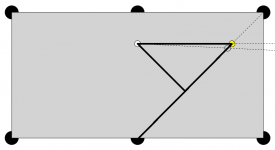SkinnyPete
Registered
I've gone over the poolology book and I like the simplicity of the system. Spending some time with it on the table has really helped me to learn to quickly identify 1/4, 1/2, 3/4 ball hits.
Now I've run into some confusion and I don't know if these are holes in the system or if I screwed up somewhere And I apologize if this has already been covered.
Looking at a diagram of a table, long sides horizontal, let's say the we have an object ball 1 diamond from the top and 1 diamond from the right side. Lets say the target pocket is the closest pocket, the top right corner pocket. The object ball sits on the dividing line of zone A and zone B, either way it has a position value of X.
The cue ball is sitting 1 diamond from the top rail, so its natural line through the object ball and to the short rail obviously is 1 diamond from the top, giving it an alignment value of X.
This says X/X or 100% of the cue ball needs to overhang? in other words too thin to cut? looks like a makeable shot to me. Am I applying the system incorrectly here?
(My software says this particular shot has a 74% overhang)

Another problem I came up on is the side pocket aiming zone numbering doesn't add up. Take diagram D, lets say your object ball is sitting on position value 50 somewhere, the cue ball is below the obj ball so the natural line points to the opposite side of the table. What doesn't make sense to me is the values at the opposite end of the tables around the top right pocket. As my cue ball moves from left to right under the obj ball, the cut to the side pocket gets thinner and thinner, how is it that my alignment value goes up as it moves up the long rail and then goes back down when it turns the corner onto the top short rail?
Now I've run into some confusion and I don't know if these are holes in the system or if I screwed up somewhere And I apologize if this has already been covered.
Looking at a diagram of a table, long sides horizontal, let's say the we have an object ball 1 diamond from the top and 1 diamond from the right side. Lets say the target pocket is the closest pocket, the top right corner pocket. The object ball sits on the dividing line of zone A and zone B, either way it has a position value of X.
The cue ball is sitting 1 diamond from the top rail, so its natural line through the object ball and to the short rail obviously is 1 diamond from the top, giving it an alignment value of X.
This says X/X or 100% of the cue ball needs to overhang? in other words too thin to cut? looks like a makeable shot to me. Am I applying the system incorrectly here?
(My software says this particular shot has a 74% overhang)

Another problem I came up on is the side pocket aiming zone numbering doesn't add up. Take diagram D, lets say your object ball is sitting on position value 50 somewhere, the cue ball is below the obj ball so the natural line points to the opposite side of the table. What doesn't make sense to me is the values at the opposite end of the tables around the top right pocket. As my cue ball moves from left to right under the obj ball, the cut to the side pocket gets thinner and thinner, how is it that my alignment value goes up as it moves up the long rail and then goes back down when it turns the corner onto the top short rail?
Last edited:
